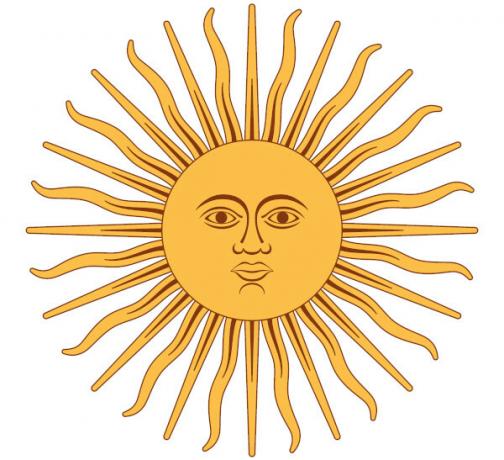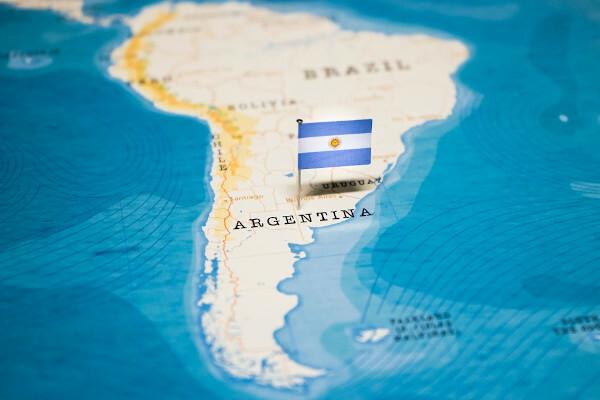A Argentina flag is one of the most important national symbols of this South American country. It features two sky-blue stripes and a centralized white stripe, all horizontally, with the figure of Sol de Maio positioned in the center of the rectangle.
The flag was made by Manuel Belgrano and officially adopted in 1816, after the country's independence. Sol de Maio, in turn, is a creation of Juan de Dios Rivera and was officially incorporated in 1818.
Read too: Brazil vs Argentina — where did this rivalry come from?
Topics of this article
- 1 - Summary about the flag of Argentina
-
2 - Meaning of the flag of Argentina
- Sun of May
- 3 - History of the flag of Argentina
- 4 - Argentina
- 5 - Flag of Argentina and flag of Uruguay
- 6 - Curiosities about the flag of Argentina
Abstract about the flag of Argentina
The Argentine flag is one of the country's national symbols.
Its official colors are the sky blue, white and golden yellow of the Sun of May positioned in the center.
Among different interpretations, the most popular says that the sky blue represents the Argentine sky and the white represents its clouds.
The Sun of May, which is in the center of the flag, was made by goldsmith Juan de Dios Rivera, in allusion to the Inca god of the Sun.
The Argentine flag was designed by Manuel Belgrano.
It was officially adopted in 1816 and ratified in 1818, the year in which Sol de Maio was added.
Argentine flag meaning
the flag of Argentina it is formed by three horizontal bands that are arranged in the following color order: sky blue, white and sky blue again. There is more than one interpretation for the meaning of the colors of the Argentine flag. In the most widespread and popular of them, the sky blue represents the country's blue sky, although this color is also associated with the idea of \u200b\u200bfreedom and independence.
Sky blue can also be seen as a reference to the colors used by the House of Bourbon, monarchical dynasty of French origin who also reigned in Spain in the 18th century and had a direct influence on the Spanish colonies in North America South.
Do not stop now... There's more after the publicity ;)
The white color, which appears in the central band of the Argentine flag, also gives rise to different interpretations. The main one declares that the white represents the clouds of the argentinian sky, referring to the feeling of peace.
Being an Andean country, it is believed that white can represent the snow that falls on the mountains and covers the top of the highest points in the country. In the center of the white stripe is the Sol de Maio, which carries an important symbology for Argentina.
Sun of May
The Sol de Maio (or Sol de Mayo in Spanish) is a yellow-gold and brown figure with a human face that is positioned exactly in the center of the flag of Argentina. It is composed of a total of 32 rays: half of them are flaming and spin clockwise, while the other the other half, arranged alternately between the rays in apparent movement, is represented in a rectilinear.
There is a historical explanation for why the Sun of May has become a very significant symbol for Argentina and displayed on its flag, on the national shield and also minted on coins.
The revolution that resulted in the independence of the United Provinces of the Río de la Plata (which until then were not so named), which included Argentina, began on May 25, 1810. During the first mass celebrated in support of the political emancipation of the Spanish colonies, the sun came out after a rather rainy and cloudy day, something seen as a positive sign. For this reason, the symbol was later called the Sun of May.
A illustration, so well known today, was made by the Peruvian goldsmith Juan de Dios Rivera (1760–1843) and used in other national symbols, such as the Argentine coat of arms. Rivera was asked to create a national symbol for the country, and the goldsmith suggested, among others, a representation of the Inca god of the sun, called Inti.
A adoption of the Sol de Maio on the flag, however, only occurred in the year 1818, in the so-called main flags (bandera mayor, in Spanish) or of war. Law number 23,208 of 1985 promoted the unification of the flags and determined that, from then on, the application do Sol de Maio was obligatory and it should always appear in the center of the rectangle of the national flag of the Argentina.

History of the flag of Argentina
the flag of Argentina was conceived by the then General Manuel Belgrano (1770–1820), in February 1812, during the war for independence in Argentina and the other South American provinces that were under Spanish rule.
Initially, the tie (insignia) used by the Argentine army from the 1810 revolution was created, which It was made in sky blue and white, which later became the national colors of the Argentina. Belgrano used these same colors to make the flag in 1812, which took place in the region of Rosário, located on the left bank of the Paraná River. The symbol was then formed by a white band at the top and blue at the bottom and was flown for the first time on August 23, 1812.
The flag with three stripes in the pattern we know today was Officially adopted on July 20, 1816, after the official proclamation of the independence of the United Provinces of the Río de la Plata. The determination was carried out by the Congress of Tucumã. Two years later, in 1818, the Sol de Maio, which until then had been used on coins and on the Argentine shield, became be part of the national flag of the country upon approval by the same legislative body cited above previously.
Read too: Flag of Brazil: the history and meaning of this national symbol
Argentina
Argentina is the second largest country in South America, with an extensive coastline to the southeast and established borders with Chile, Bolivia, Paraguay, Brazil and Uruguay. The Argentine capital is the city of Buenos Aires.
One of Argentina's main geomorphological features is the Andes Mountain Range, which runs north-south across the west of the country. The north of the Argentine territory is characterized by the presence of the pampas, while in the south the characteristic relief of the Patagonian plateau predominates. O climate in Argentina ranges from temperate to polar in the extreme south of the country.
The country is very populous and currently has 45,196,000 inhabitants. Approximately one third of this total, 15 million people, is concentrated in Buenos Aires, the main economic and cultural center of the country. Argentina is today the third largest economy in Latin America, common GDP which reached 382 million dollars in 2020.

A Argentine industry is quite diverse and ranks second in terms of its share in the country's economy. Argentina has many natural resources (lead, iron, iron ore, oil), among which are the fertile lands to the north. In this way, modern agriculture was developed, with a strong external orientation and which stands out in the production of beef, corn, soy and wheat.
Argentina flag and Uruguay flag

A flag of Uruguay has similar elements those used in the flag of Argentina, but they are quite different with regard to the distribution of such elements in the space, in the color scheme and even in the representation of the Sun of May, which became a symbol of the independence of both countries.
Nine stripes that alternate between white and blue make up the Uruguayan flag. In the upper left corner, called the canton, it is possible to observe the Sol de Maio with a total of 16 rays, half of which are in apparent clockwise movement. Its design was inspired by the American flag, as well as the Argentine flag.
You Sun rays of the Uruguayan flag are represented in two colors, yellow and brown, and the figure also has a human face in its center. The representativeness of the sun is the same as for Argentina, since the declaration of its independence from Spain was declared on the same day. The Uruguayan flag, as we know it today, was officially adopted on June 11, 1830 and made by the then head of government Joaquín Suárez (1781–1868).
Read too:Flag of England — the history of the flag that bears the Cross of St George
Curiosities about the flag of Argentina
June 20 was established as Flag Day in Argentina, considered a national holiday. The date was chosen because it was the day its creator, Manuel Belgrano, died in 1820.
The Flag Monument was erected in the city of Rosario, where the flag of Argentina was created.
Between 1819 and 1820, the blue tone of the Argentine flag was changed to a darker tone, as negotiations with France were underway.
By Paloma Guitarrara
Geography Teacher
Read our text and deepen your knowledge about South America. Learn more about the geography, economy, culture and history of this subcontinent.
Learn the meaning of the colors and symbols of the Costa Rican flag. See the main geographical features of this small Central American country.
Know the main details of the flag of Spain! Learn the meaning of their colors and the Spanish coat of arms. Also learn the history of this flag.
Click and learn about the history of the flag of England, an important national symbol of the country. Compare it with the flag of the United Kingdom and find out the main differences.
Access and learn about the history of the flag of Mexico! Know the meaning of its colors and learn about the symbology of the Mexican coat of arms. See some curiosities.
Access and learn about the meaning of Sol de Maio present on the flag of Uruguay. Know what your colors represent. Read the history of the Uruguayan flag.
Access the text to learn more about Cristina Kirchner's career. Learn more about the political career of this traditional figure in Argentine politics.
Learn a little more about the history of Argentina, a country in South America that suffered from Spanish colonization.


